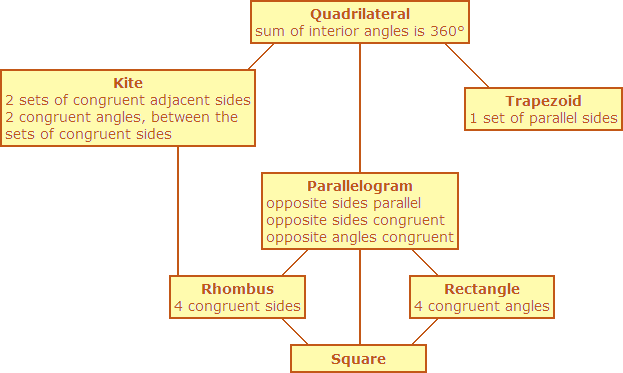2-Dimensional Figures
5th Grade
|
|
|
Alabama Course of Study Standards:
23
|
Explain that attributes belonging to a category of two-dimensional figures also belong to all subcategories
of that category.Example: All rectangles have four right angles, and squares have four right angles, so squares are
rectangles. |
Arizona Academic Standards:
5.G.B.3
|
Understand that attributes belonging to a category of two-dimensional figures also belong to all subcategories of that category. |
Common Core State Standards:
Math.5.G.3 or 5.G.B.3
|
Understand that attributes belonging to a category of two-dimensional figures also belong to all subcategories of that category. For example, all rectangles have four right angles and squares are rectangles, so all squares have four right angles. |
Georgia Math and ELA Standards:
5.GSR.8.2
|
Determine, through exploration and investigation, that attributes belonging to a category of two-dimensional figures also belong to all subcategories of that category. |
North Carolina - Standard Course of Study:
5.G.3
|
Classify quadrilaterals into categories based on their properties.- Explain that attributes belonging to a category of quadrilaterals also belong to all subcategories of that category.
- Classify quadrilaterals in a hierarchy based on properties.
|
New York State Next Generation Learning Standards:
5.G.3
|
Understand that attributes belonging to a category of two-dimensional figures also belong to all subcategories of that category.
e.g., All rectangles have four right angles and squares are rectangles, so all squares have four right angles.
Note: The inclusive definition of a trapezoid will be utilized, which
defines a trapezoid as "A quadrilateral with at least one pair of parallel sides." |
Ohio's Learning Standards:
5.G.3
|
Identify and describe commonalities and differences between
types of triangles based on angle measures (equiangular, right, acute,
and obtuse triangles) and side lengths (isosceles, equilateral, and
scalene triangles). |
Wisconsin Academic Standards:
5.G.B.3
|
Understand that attributes belonging to a category of two-dimensional figures also belong to all subcategories of that category.
For example, all rectangles have four right angles and squares are rectangles, so all squares have four right angles. |
Alabama Course of Study Standards:
22
|
Classify quadrilaterals in a hierarchy based on properties. |
Common Core State Standards:
Math.5.G.4 or 5.G.B.4
|
Classify two-dimensional figures in a hierarchy based on properties. |
Louisiana Academic Standards:
5.G.B.4
|
Classify quadrilaterals in a hierarchy based on properties. (Students will define a trapezoid as a quadrilateral with at least one pair of parallel sides.) |
Massachusetts Curriculum Frameworks:
5.G.B.4
|
Classify two-dimensional figures in a hierarchy based on properties. For example, all rectangles are parallelograms because they are all quadrilaterals with two pairs of opposite sides parallel. |
Ohio's Learning Standards:
5.G.4
|
Identify and describe commonalities and differences between
types of quadrilaterals based on angle measures, side lengths, and
the presence or absence of parallel and perpendicular lines, e.g.,
squares, rectangles, parallelograms, trapezoids, and rhombuses. |
Tennessee Academic Standards:
5.G.B.3
|
Classify two-dimensional figures in a hierarchy based on properties. Understand that attributes belonging to a category of two-dimensional figures also belong to all subcategories of that category. For example, all rectangles have four right angles and squares are rectangles, so all squares have four right angles. |
Pennsylvania Core Standards:
CC.2.3.5.A.2
|
Classify two-dimensional figures into categories based on an understanding of their properties. |
Pennsylvania Core Standards:
M05.C-G.2.1.1
|
Classify two-dimensional figures in a hierarchy based on properties. |
Georgia Math and ELA Standards:
5.GSR.8.1
|
Classify, compare, and contrast
polygons based on properties. |
Georgia Math and ELA Standards:
5.GSR.8.2
|
Determine, through exploration
and investigation, that attributes
belonging to a category of twodimensional figures also belong to
all subcategories of that
category. |
Arkansas Academic Standards:
5.GM.1
|
Classify two-dimensional figures in a hierarchy based on properties with the focus on quadrilaterals and triangles when teaching hierarchies.- Shapes to include: quadrilaterals (trapezoid, parallelogram, rectangle, square, rhombus, kite) and triangles (right, acute, obtuse, scalene, isosceles, equilateral)
|
|
|


 5th Grade Math - 2-Dimensional Figures Lesson
5th Grade Math - 2-Dimensional Figures Lesson




